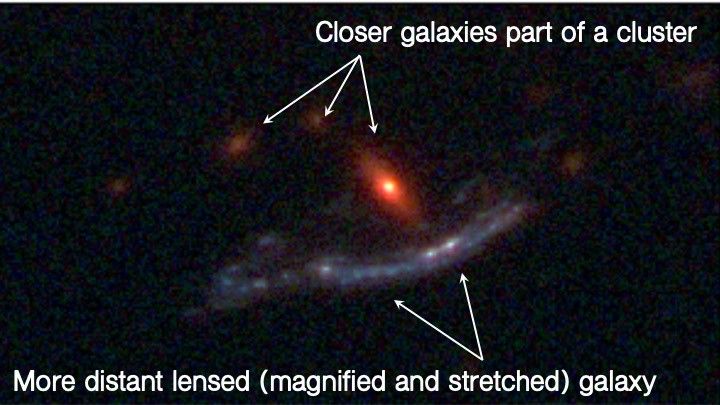Cosmic telescope reveals inner workings of two proto-galaxies
/wider-deeper-faster_E6A1458.JPG)
Professor Jeff Cooke (pictured) worked with an international team to observe the formative inner workings of two Damped Lyman-α systems (DLAs) for the first time.
In summary
- Swinburne researchers have observed the formative inner workings of two Damped Lyman-α systems (DLAs) for the first time.
- DLAs are giant gas clouds that formed galaxies
in the early Universe, not long after the Big Bang.
- With diameters greater than 17.4 kiloparsecs,
DLAs are more than two thirds the size of the Milky Way galaxy today.
Using a unique new instrument and a little help from nature, Swinburne researchers have gotten the first in-depth view of the enormous gas clouds that serve as galactic nurseries.
Working internationally with researchers from North Carolina State University and the W.M. Keck Observatory, astronomers have observed the formative inner workings of two Damped Lyman-α systems (DLAs) for the first time. DLAs are giant gas clouds that formed galaxies in the early Universe, not long after the Big Bang.
“DLAs are crucial in understanding how galaxies were formed, but have traditionally been extremely difficult to observe,” says Swinburne University of Technology Professor Jeff Cooke, one of the authors on the recently published paper in Nature.
“By using the powerful capabilities of the W.M. Keck Observatory, some fortuitous alignments of galaxies, and Einstein’s general relativity, we are able to observe and study these massively important objects in a completely new way, giving us insight into how the stars and planets around us were formed.”
These DLAs are not just massively important; they are also massive, as this study finds. With diameters greater than 17.4 kiloparsecs, they’re more than two thirds the size of the Milky Way galaxy today. It would take light more than 50,000 years to travel across each of them.
Developing a cosmic telescope
After the Big Bang, DLAs served as galactic nurseries, fueling the formation of galaxies comprised of stars and gas. But observing them has been hard as they are made predominately of hydrogen, which doesn’t shine or glow.
Astrophysicists have traditionally used bright quasars – supermassive black holes that emit light – as backlights to search for DLAs. While this method does allow researchers to find DLAs, the light from a quasar provides only a small skewer through the massive cloud, like a pinprick poked into a sheet of paper.
“Background” galaxies can provide very large backlights for observation, as they are 100 million times larger than quasars in this context. However, galaxies are typically too faint for this purpose.
Working with Swinburne’s Professor Cooke, Dr Rongmon Bordoloi from North Carolina State University and John O’Meara, Chief Scientist at the W.M. Keck Observatory in Hawaii, found a way around the problem by using a gravitationally lensed galaxy and integral field spectroscopy.

A Hubble Space Telescope image of the galaxy system explored in this work. Supplied: Professor Jeff Cooke.
“Gravitationally lensed galaxies refer to galaxies that appear stretched and brightened,” Dr Bordoloi says. “The light bends as it travels toward us, so we end up looking at an extended version of the object – it’s like using a cosmic telescope that increases magnification and gives us better visualization.”
The bending and magnification of the galaxy light is due to general relativity.
Innovative spectrum readings
Spectrum readings allow astrophysicists to “see” elements in deep space from their atomic signatures that are not visible in images. This helps understand the extent of the gas, its motion, and the elemental composition of the DLAs.
Normally, gathering the readings is a long and painstaking process. But the team solved the issue by performing integral field spectroscopy with the Keck Cosmic Web Imager that can gather spectra over many parts of the DLAs simultaneously.
This innovation, combined with the stretched and brightened gravitationally lensed background galaxy, allowed the team to map out the diffuse gas in the two DLAs at high fidelity.
"By utilizing the latest technology at Keck and a little luck with the alignment of gravitationally lensed galaxies, we have greater insight into the workings of our universe than ever before,” Professor Cooke says.
Swinburne is the only Australian university with guaranteed access to W.M. Keck Observatory telescopes – the world's largest and most productive optical/infra-red telescopes – more than 9,000 kilometres from Melbourne.
The work appears in Nature and was supported by the National Aeronautics and Space Administration, the W.M. Keck Foundation, the National Science Foundation, and the Australian Research Council Centre of Excellence for All Sky Astrophysics in 3 Dimensions (ASTRO 3D).
-
Media Enquiries
Related articles
-

- Astronomy
High school students work with Swinburne astronomers on the future of space
Swinburne’s Youth Space Innovation Challenge has inspired over 330 Australian teenagers to pursue a career in STEM.
Friday 26 July 2024 -

- Astronomy
- Science
Swinburne appoints new Director of Innovative Planet Research Institute
Leading geodesy expert, Professor Allison Kealy, has been appointed as the inaugural Director of Swinburne University's Innovative Planet Research Institute.
Monday 22 April 2024 -

- Astronomy
- University
OzGrav 2.0: A ‘new era of astrophysics’ launched at Swinburne
The next phase in the world-leading ARC Centre of Excellence for Gravitational Wave Discovery, dubbed 'OzGrav 2.0', launched this week at Swinburne University of Technology.
Wednesday 17 April 2024 -

- Design
- Astronomy
- Technology
- University
Swinburne ‘Rock Muncher’ takes part in Australian Rover Challenge
A multidisciplinary student team from Swinburne University of Technology competed in the 2024 Australian Rover Challenge held in Adelaide, South Australia.
Thursday 11 April 2024 -
.jpeg/_jcr_content/renditions/cq5dam.web.256.144.jpeg)
- Astronomy
New JWST observations reveal black holes rapidly shut off star formation in massive galaxies
New research showcases new observations from the James Webb Space Telescope that suggest black holes rapidly shut off star-formation in massive galaxies by explosively removing large amounts of gas...
Tuesday 23 April 2024

